Introduction: In this article, Mary Harrell-Sesniak writes about interesting Revolutionary War-era discoveries she’s found in old newspapers. Mary is a genealogist, author and editor with a strong technology background.
Genealogists, by the very nature of what we do, have a keen interest in history. One of my more unusual interests is reading about and transcribing reports from the American Revolutionary War.
Perhaps it is because I have identified numerous ancestors in my family tree who were patriots during that war. This interest has been heightened by finding so many Revolutionary War newspaper articles in GenealogyBank’s online Historical Newspaper Archives.
In this article I’d like to share a few of the unusual Revolutionary War-era stories I’ve found during my ancestor searches, most of them extracted from newspaper obituaries. Keep in mind that to various lineage societies (DAR, SAR, etc.) the definition of “patriot” is not limited to military service. I happen to agree with that assessment: it’s possible to serve your country in many non-military ways during wartime, such as:
- Belonging to a member of a committee of safety or correspondence
- Manufacturing goods and providing necessary services
- Attending to or assisting veterans
Some of these services during the Revolutionary War are described in copious detail in old newspapers from that time. These old newspaper articles are a great resource to discover the stories of lesser-known Revolutionary War heroes. Other types of wartime participation are not as well reported, such as the role played by Uriah Hanks, of Mansfield, Connecticut. He provided a key service during the American Revolution: he manufactured gunlocks for the Colonial troops. Hanks passed away on 4 July 1809 at the age of 74. Although I have found several death notices for him, none that I located mentioned the exact date of his death—or his occupation.

It’s necessary in genealogy research to consult a range of resources, and I have found additional information about Hanks in DAR records, vital records, books, and from his tombstone at Old Storrs Cemetery in Storrs, Connecticut.
Notable & Famous People in the Revolutionary War
One of the interesting facts about our country is that two Founding Fathers and presidents, John Adams and Thomas Jefferson, died within hours of each other on 4 July 1826. Both of these patriots’ careers were well covered by the newspapers of the time, and you can find numerous articles about them.
However, there is another Founding Father who is seemingly overlooked, who also passed away on our country’s birthday—like Hanks, Adams and Jefferson. His name was Fisher Ames (9 April 1758-4 July 1808), a member of the Continental Congress.
Ever heard of him?
I imagine he is not a household name, but he should be, as he was the penman of the 1st Amendment to our Bill of Rights.
“Congress shall make no law respecting an establishment of religion, or prohibiting the free exercise thereof; or abridging the freedom of speech, or of the press; or the right of the people peaceably to assemble, and to petition the Government for a redress of grievances.”
The congressional election of 1788 pitted Ames against Samuel Adams, which he won handily, although Samuel Adams did gain a seat in the second Congress.
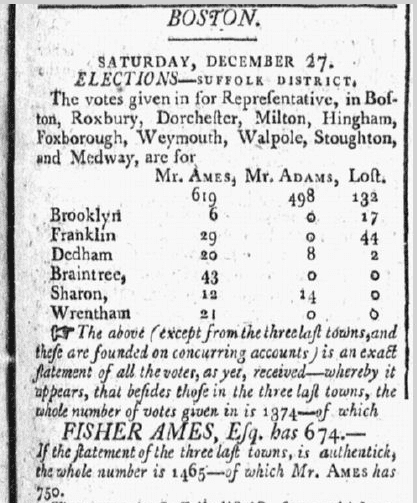
When he died, Ames’s obituary described him as “a most eloquent orator, enlightened statesman, ardent and anxious patriot, virtuous and amiable man”:
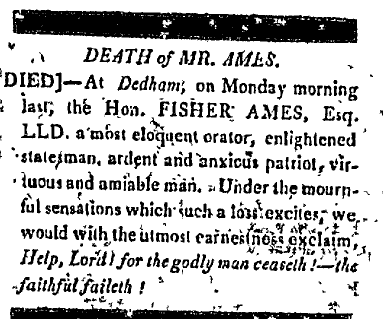
I recommend taking the time to read the Columbian Centinel (Boston, Massachusetts) of 6 July 1808, which mentions his widely-attended funeral, including most of the important dignitaries of the time including Supreme Court Justices, Members of Congress, the Attorney General, Members of the Senate, etc.
Minority Patriots in the Revolutionary War
Surprisingly, we can locate a respectable number of articles about minority patriots in Revolutionary War-era newspapers. The first African American who fell during the struggle was Crispus Attucks, at the Boston Massacre. He is barely mentioned in the Boston New-Letter (Boston, Massachusetts) report on 15 March 1770, but received more coverage in later reports.
“Last Thursday, agreeable to a general request of the Inhabitants, and the consent of Parents & others, were followed to their Grave in succession…two of the unfortunate Sufferers, viz. James Caldwell & Crispus Attucks, who were strangers, borne from Faneuil Hall, attended by a numerous train of Persons of all ranks…”
There are newspaper articles about Native Americans and minority pensioners in the Revolutionary War, as in the following death notice examples:
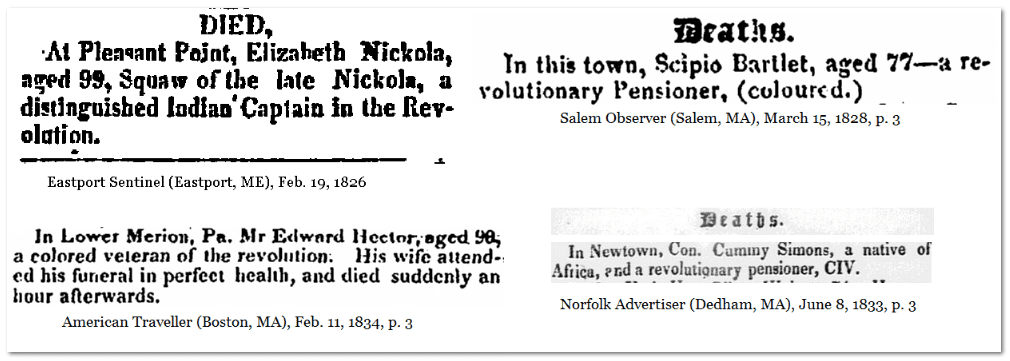
A fire in the War Department on 8 November 1800 destroyed many military records, and additional records were lost during the War of 1812, but, fortunately, we can locate most pension records after that time frame.
For example, the record of Cummy Simon (or Simons) Revolutionary War Pension S.36315, available from the National Archives or at Fold3.com, reports that he enlisted in June of 1777 in Capt. Granger’s Company (Col. Charles B. Webb’s Regiment), and wasn’t discharged until June of 1783. There is also a letter which names two children, Cummy Simon and Minerva Cable, a welcome addition to any family history research.
Women of the Revolutionary War
I’d like to conclude this article with reports of female Revolutionary War patriots. There are a number of noted women who served during the Revolutionary War, including the “Molly Pitchers” (women who fought in the war; the most famous was Mary Ludwig Hays McCauley), Emily Geiger, Dicey Langston and Deborah Samson (who disguised herself as a man named Robert Shirtliffe in order to fight). Some of their obituaries can be found at the time of their demise, and longer reports can be read from later periods of recognition when towns or lineage societies took the time to commemorate them.
Here is the obituary of one of the women patriots during the Revolutionary War, Mary Wyckoff, that notes: “Many a soldier has to mourn her death, and reflect with gratitude on the generosity and aid afforded them at Fishkill [New York], during the late revolution, when she fed the hungry, cloathed the naked, and protected the unfortunate from the fury of the British troops.”
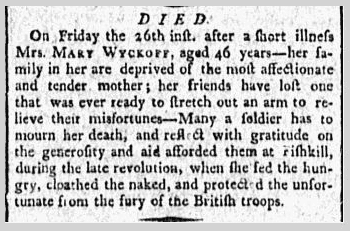
The courageous Margaret Keysor seems to have fallen through the cracks of history. Shortly after the Battle of Oriskany, her husband and two sons were captured by Indians and Tories. Margaret escaped with her five children and fled to a nearby fort, which ended up being guarded by two invalid soldiers who were protecting 200 women and children! When the fort was attacked the women and children picked up weapons and fought for their lives until reinforcements arrived.
When Margaret died 46 years later in 1823, her obituary recalled the brave fight she participated in:
“Here she sought shelter in the fort, and remained while Major Brown, with a battalion under his command, marched out to join the forces under General Van Rensselaer. Major Brown and his whole corps, with the exception of thirteen men, fell in the action which ensued: thus was the place left with but two invalid soldiers to protect two hundred women and children. The fort was immediately besieged by the combined forces of British and Indians, but the hand of Heaven can, in times of necessity, convert even women and children into soldiers. By this apparently feeble and inefficient band, was the place defended until reinforced, and the enemy abandoned the enterprise.”
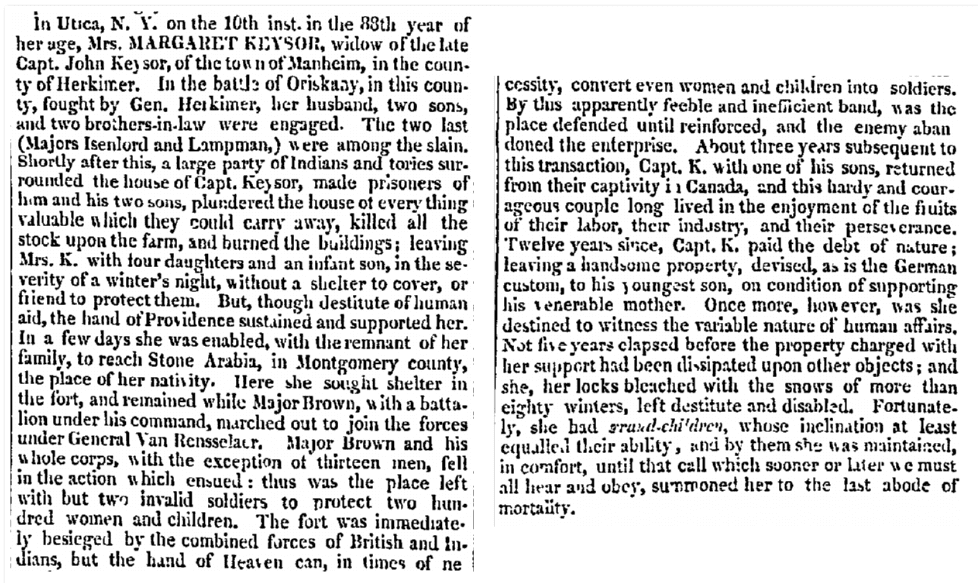
This is the kind of exciting story Revolutionary War-era newspapers can tell us about little-known patriots during that legendary struggle!
If you enjoy reading reports from the American Revolution, I invite you to join me on my Facebook page at www.facebook.com/500RevWarObits
The Daughters of the American Revolution published a reference in 2008 that is available for download on Forgotten Patriots, with a supplement in 2012.

It appears you have some interesting information on some of the Hanks family! I am currently writing a second book, branching out from the core family tree that I have in the first book. At present, I am researching the Abraham Hanks/Lucy Jennings, whom I believe Baber used as the husband of Sarah Harper. I found her in the Turkey Creek church as Mrs. Alex and Sarah Harper! I am also researching the William Lee line, as Ann Lee Hanks was William Lee III daughter.